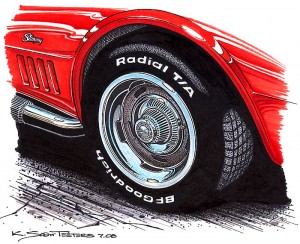Dateline: 7.10.2011
A Historic Look Back at the Wheels that Vettes Ride On!
1968 was a major turning point in the Corvette story with the introduction of the Mako Shark II-inspired C3 Corvette. The Mako Shark II was first unleashed as a Chevrolet show car to test the market’s feelings towards the radically styled “futuristic” Corvette. The response was thunderous and the all-new body design and interior was fast-tracked into production. But making a show car into a real car is no easy task. The C3 was supposed to be introduced as a ‘67 model but wasn’t ready in time. The basic chassis and drive train was a carry-over from the ‘63 – ‘67 Sting Ray, which puts the suspension design date in the early ‘60s. At the time, no one imagined that the C3 would have a 15 year production run. Along the way, Corvette stylists kept the car fresh-looking with bumper cover, hood, fender vents, and wheels updates.
Despite the aging hardware, buyers made the Corvette a runaway success with a best-ever sales year in ‘79 with 53,807 units sold. The only other year that broke the 50K production figure was the ‘84 model with 51,547 units.
(To see larger versions of all of the below images, just click the image.)

Your Basic, Slightly Wider Stamped Steel Wheel
The arrival of the ‘68 Corvette represented the most dramatic styling change in the history of the car. The change between the ‘67 and ‘68 Corvette was even more radical than the ‘62 to ‘63 styling change. Simply put, the new C3 was unlike anything else on the road. There were some comparisons to a few Ferrari and Maseratti cars, but those similarities were restricted to the sensuous fender curves and attitude.
Tailoring the Mako Shark II’s show car lines was not an easy task. It was reported that the biggest challenge was trimming down the Mako Shark II’s large front fender humps so that the driver could have a relatively clear view forward. Nearly the entire chassis and running gear was a carry-over from the ‘67 Corvette, including the base car’s wheel design. The 5-slotted, stamped steel Rally Wheel, with beauty rings and caps was a carry-over from the ‘67 design, but was one-inch wider. The new 15” x 7” wheel was the widest wheel to that date for the Corvette. The tire size was bumped up as well. The ‘67 wheel set road on 7.75” x 15” tires on 15” x 6” wheels. Beginning in ‘68, tires sizes were measures in “series” which represented the Continue reading “Corvette Wheels Pt 2 of 3 – 1968 to 1996”


